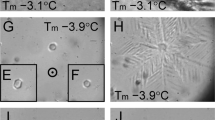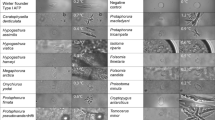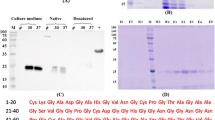Abstract
We have discovered an antifreeze protein1 in an overwintering perennial ryegrass, Lolium perenne. The protein is stable at 100 °C and although it is a less effective antifreeze than proteins found in antarctic fish and insects, it is better at preventing ice recrystallization. This property enables grasses to tolerate ice formation in their tissues without being damaged, suggesting that the control of ice-crystal growth rather than the prevention of freezing may have evolved to be the critical factor in their survival at very low temperatures.
Similar content being viewed by others
Main
Frost-tolerant plants undergo a process of cold acclimation2,3, during which perennial grasses accumulate a boiling-tolerant protein that inhibits ice recrystallization. We extracted the protein responsible for this activity from cold acclimated leaves of L. perenne and cloned its complementary DNA by using the polymerase chain reaction4. We found that it had an open reading frame encoding a protein of 118 amino acids (GenBank accession number, AJ277399) and relative molecular mass 11.765K, with six potential N-glycosylation sites containing the conserved N-X-S/T glycosylation motif.
Although this boiling-tolerant antifreeze protein (AFP) belongs to a new class of plant proteins and shares no lengthy sequence homology with any other AFP or protein sequence, some of its properties fit with the general pattern for AFPs. It is very hydrophilic, being rich in asparagine (25%), valine (16%), serine (15%) and threonine (10%), and having very few amino acids with aromatic or hydrophobic side chains. The primary structure has a series of highly conserved, 7-amino-acid repeat sequences with regularly spaced serine and threonine residues that may be able to hydrogen-bond with an ice surface. Growth of a single ice-crystal hemisphere from a dilute solution of the protein, and subsequent surface-etching of the ice hemisphere5, produced a distinctive pattern with six-fold symmetry, demonstrating that the protein was specifically binding to ice on the primary prism plane (Fig. 1a,b).
Lolium AFP binds specifically to an ice-crystal surface with six-fold symmetry. a,b, Ice-etching determination of the binding planes using the hemisphere technique5: a, three elongated patches positioned on the primary prism plane; and, b, the planes symmetrically arranged around the crystal's c-axis. c,d, Influence of Lolium AFP on ice recrystallization. The recrystallization inhibition assay shows crystal growth after 60 min at −6 °C; Lolium perenne (d) inhibits recrystallization of ice in dilute concentrations relative to growth with the 30% sucrose control (c). Scale bar, 50 μm.
The Fourier-transform infrared spectrum of this grass AFP in solution at room temperature revealed a high solvent-exposed β-sheet content which may be exposed at the ice-binding surface6, as proposed for several other antifreeze proteins, including that from carrot and types II and III from fish. The spectrum was the same in the presence of ice, suggesting that the conformation of the Lolium AFP does not change on binding to ice, unlike that of the insect Dendroides canadensis thermal- hysteresis protein, which does7.
Our Lolium antifreeze protein had a significantly higher specific activity in an ice-recrystallization inhibition assay8 than other antifreeze proteins. Growth of ice crystals in 30% sucrose solution was completely inhibited at AFP concentrations below 10 μg ml−1 (Fig. 1c,d), which is at least 200 times less in molar terms than the type III AFP from ocean pout (Macrozoarces americanus ).
In contrast, Lolium AFP shows a low thermal hysteresis (the lowering of the temperature at which ice forms on cooling while the melting temperature remains unaltered9), with the highest measurable value being 0.1 °C in water and 0.45 °C in 30% sucrose; these values are much lower than the 1.0–1.5 °C reported for fish AFP10 and the 5–6 °C reported for insect proteins11, although these too are increased by sucrose12.
Mechanisms previously proposed to explain how AFPs work all imply some correlation between thermal hysteresis effects and recrystallization inhibition13. Our discovery that there is no correlation between these relative activities of the antifreeze protein from L. perenne raises questions about the nature of the AFP mechanism and indicates that different classes of AFP may interact with ice in different ways. We propose that the thermal hysteresis activity of the grass protein is unlikely to serve an important protective function at the very low temperatures survived by overwintering grasses, whereas its capacity to control the growth of ice crystals may protect it against damage to the plant cellular structure.
References
Feeney, R. E. & Yeh, Y. Food Technol. 47, 82–88 (1993).
Thomashow, M. F. Adv. Genet. 28, 99–131 ( 1990).
Guy, C. L. Annu. Rev. Plant Physiol. 41, 187– 223 (1990).
Frohman, M. A., Dush, M. K. & Martin, G. R. Proc. Natl Acad. Sci. USA 85, 8998–9002 (1988).
Knight, C. A., Cheng, C. & DeVries, A. L. Biophys. J. 59, 409– 418 (1991).
Arrondo, J. L. R., Young, N. M. & Mantsch, H. H. Biochim. Biophys. Acta 952, 261–268 (1988).
Li, N., Kendrick, B. S., Manning, M. C., Carpenter, J. F. & Duman, J. G. Arch. Biochem. Biophys. 360, 25–32 ( 1998).
Worrall, D. et al. Science 282, 115–117 (1998).
Knight, C. A., DeVries, A. L. & Oolman, L. D. Nature 308, 295– 296 (1984).
Duman, J. G., Wu, D. W., Olsen, T. M., Urrutia, M. & Tursman, D. Adv. Low-Temp. Biol. 2, 131– 182 (1993).
Graham, L. A., Liou, Y.-C, Walker, V. K. & Davies, P. L. Nature 388, 727–728 ( 1997).
Li, N., Andorfer, C. A. & Duman, J. G. J. Exp. Biol. 201, 2243– 2251 (1998).
Hall, D. G & Lips, A. Langmuir 15, 1905–1912 (1999).
Author information
Authors and Affiliations
Corresponding author
Rights and permissions
About this article
Cite this article
Sidebottom, C., Buckley, S., Pudney, P. et al. Heat-stable antifreeze protein from grass . Nature 406, 256 (2000). https://doi.org/10.1038/35018639
Issue Date:
DOI: https://doi.org/10.1038/35018639
This article is cited by
-
Physiological Change and Transcriptome Analysis of Chinese Wild Vitis amurensis and Vitis vinifera in Response to Cold Stress
Plant Molecular Biology Reporter (2020)
-
A brief review of applications of antifreeze proteins in cryopreservation and metabolic genetic engineering
3 Biotech (2019)
-
Proteomics: A tool to decipher cold tolerance
Theoretical and Experimental Plant Physiology (2019)
-
Polymer mimics of biomacromolecular antifreezes
Nature Communications (2017)
-
Purification and Identification of Antifreeze Protein From Cold-Acclimated Oat (Avena sativa L.) and the Cryoprotective Activities in Ice Cream
Food and Bioprocess Technology (2016)
Comments
By submitting a comment you agree to abide by our Terms and Community Guidelines. If you find something abusive or that does not comply with our terms or guidelines please flag it as inappropriate.




